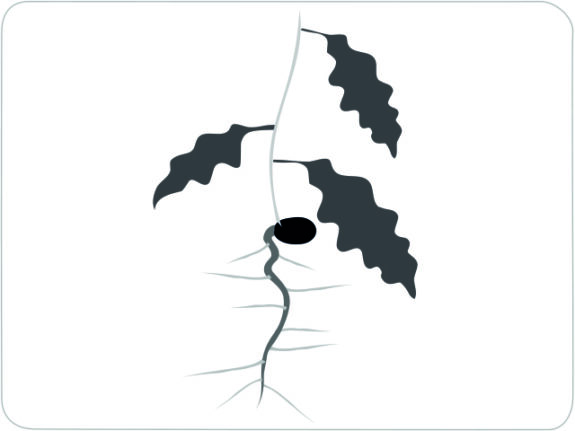
Growing language
In a matrix of levels
All languages have levels of structure like the stem and roots of a plant from the seed. Most of the levels of language are obvious and incontestable. But exact definitions and the borders between the levels are not so obvious, and matters of dispute. At least some of these levels are problematic, at least to some degree, for all children, and for some children very problematic. The levels constitute a space which children have to navigate. Or they would not learn to talk. This navigation is plainly not by instinct, as by the title of Steven Pinker’s book.
It is by instinct that birds learn to fly. By the interesting experiment of Roy Dennis and Derek Gow at Knepp wilding, the babies of mother storks who were unable fly as a result of some injury and made their nests on the ground, learnt to fly just like other small storks. That was instinct kicking in.
Language is quite different. The navigation between the levels is not by progressing from one to the next. Children are not taught first the sounds of their target language, and then the words, and then the sentences. What children experience is all the levels at once. In order to navigate this space children must have a sense of how the levels relate to one another. The navigation has to be in a matrix. By the approach of Hagit Borer and Ken Wexler (1987), followed here, one key aspect of this navigation is by maturation or growth. But the growing aspect is not enough on its own. In order to learn to talk children need direct experience of listening to and using language (at least in their minds). If the experience is disturbed, so is language development.
In a very loose sense it is useful to distinguish between at least some of the following levels (Some dispute the separateness of one or more of them):
- Speech sounds (or ‘phonemes’) as represented famously badly in English, by the 26 letters of the alphabet for 44 or so phonemes;
- Syllables, with, for instance five short syllables in hippopotamus (each syllable following a consonant vowel pattern universal across human languages) in contrast to the exceptional complexity which English allows in words like strength (towards the upper end of complexity in what human languages allow);
- Words, surprisingly unobvious what these are;
- Morphemes, as ways of distinguishing between roots like wish and forms denoting ‘tense’ like the -ED in wished, pronouced as T, or ‘plurality’ or the third person singularity in the -ES in wishes, where there is more than one morpheme in both wished and wishes;
- Feet, as the basis of rhythm, giving the alternating stresses in all words of two syllables or more;
- Features of different sorts, obvious in the differences between T and D, or M and N, less obvious in the definition of ‘cases’ as in he and him, she and her, etc.;
- Phrases, as the only sort of unit on which the syntax can be defined, as in “The sister of the president of a well known multinational” and the whole of this phrase as a unit in “The sister of the president of a well known multinational’s secret privileges” with ‘s on the right edge of the phrase rather than sister, where it ‘logically’ belongs;
- Phases, or subassemblies of syntactic structure, defined on the propositionality of what is true or false, and on pragmatic force, expressing aspects of discourse, such as approval or disapproval;
- Sentences, forcibly with a particular, well-defined structure;
- Semantics, defining the understanding of structures of all sorts from morphemes to sentences;
- Utterances or pragmatic elements of discourse– which may be only a single word, Really?, Eh?, or Ah!
There are significant interactions between these levels. For example, butter and bottle both have a stressed syllable followed by an un unstressed, final syllable. In many varieties of English the way T is said is quite different in the two cases. The syllable and foot structure both interact with the pronunciation of the T . In a completely different way, we can say “I gave the picture to my brother” or “I gave my brother the picture”. And we can say “I donated the picture to the museum”, but not “I donated the museum then picture”. At least part of the issue here is that donate has the connotation that the beneficiary is worthy of some respect. Here either semantics or pragmatics is clearly interacting with syntax.
But there are questions and problems with respect to almost every term in the schema above. For instance, the notion of ‘Phase’ has only emerged over the past twenty years. And there is still vigourous debate about almost every aspect of this notion. Some linguists do not believe that there is any such thing. And there is still no such thing as a phase-based theory of acquisition. With regard to what is sometimes known as the ‘phonemic’ level, looking just at the root forms of English there are plainly different consonants in bib, dead, and gag, or pip, tot, and kick, articulated with the lips, tongue tip or back of the tongue, and variations in the timing of the articulation in the mouth and the action of the vocal cords, and mime and nine, with the lips and tongue tip, and with the airstream through the nose. But there is a gap with respect to the nasal airstream and the back of the tongue, written as NG in sing and long. It only occurs (in English and many languages) on the right edge of the syllable. So there are no words like GNISS or GNOLL. On one sort of theory (categorised here as ‘taxonomic’), the NG sound is a phoneme. Its occurrence is just restricted. The following G is pronounced in finger and hunger, and in younger, stronger and longest, but not in singer and singing. But this forces a very complex account of these forms and English varieties in which the G is pronounced in sing, or in singer, or singing. or just two or all three. There is a simpler account by postulating a two-step derivation by which the back of the tongue articulation influences the preceding nasal airstream in all cases, and then goes unpronounced in ways that vary from one variety to another. This reduces the set of English phonemes, but forces a derivation with respect to words like sing.
This bears on child-speech. Some children say snake as NGAKE. Here the back of the tongue articulation is changing not an adjacent sound, but a sound on the far side of the vowel. On a taxonomic account, such a speaker has not yet learnt the privileges of occurrence. By the framework here, the error is by an over reach of the back of the tongue effect. But there are children who say all cases of N as NG. And for them it seems to me that they have one element of the inventory wrongly defined. One such child I can think of would seem to have inherited from his father an uncommon low level of innervation in the roof of his mouth just behind his upper front teeth – plainly not a linguistic issue, but one which could impact on learning the system of speech sounds.
All of the interactions here are part of the language learner’s ‘learnability space‘, as Marlys Macken (1995) called it. Many of the interactions are specific to a language or variety – like where to pronounce the G as a G, in finger and younger, but not in sing or singer, or in all four, and so on. In another case, the insertion of an R between hosanna and in by English speaking choirs in “Hosanna in excelsis Deo” is regarded by Scottish speakers as just another oddity of the speech from South of the border. The interactions and the definitions of what is interacting with what are the topic of ongoing debate between linguists. Many linguists would dispute some of these levels. But few, if any, would seek to reduce this list to the point that there is no significant hierarchy here – between, say, speech sounds and features.
At least since the 1968 formulation of general principles underlying English word stress in Chomsky and Halle’s SPE, there is an obvious duality in English and all the other related languages of the Indo-European group between the segmentality, obvious from the fact that they can be represented by an alphabet, and the metricality of the stress system exploited in verse from Shakespeare to limericks.
All of the levels here contribute to stories, which is why stories are so valuable in developing children’s speech and language.
Looking at matters more generally
I have concentrated on the speech sounds because these often seem to be where children’s speech issues mainly lie – with one or more sounds, misarticulated, not pronounced at all, or pronounced in the wrong place – as in spaghetti as BASKETI. In any particular case, this may be due to any one of a number of possible factors. But where a ‘speech sound issue’ leads to significant incomprehensibility, this is characteristically only part of the issue. Characteristically, there are significant co-morbidities involving more than one level of structure.
in terms of the architecture of linguistic theory, by the framework here, syntax is at the centre. This ‘syntactocentric’ approach is vigorously disputed by some.

